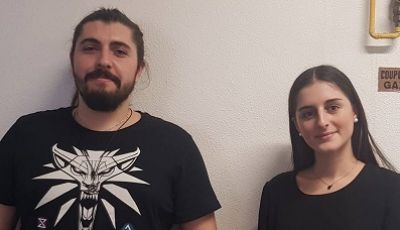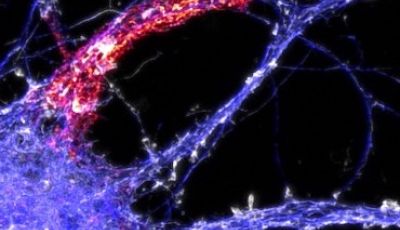Equipes de recherche
Plateforme NeuroTimone (PFNT)
La PFNT (Plateforme NeuroTimone) est un ensemble cohérent d'outils d'exploration en neurobiologie permettant des investigations aux échelles moléculaires, cellulaires et intégrées.
A la Une
-
 The GlioME team has popularized a scientific article to make its research accessible to the general public.
The GlioME team has popularized a scientific article to make its research accessible to the general public.The popularization of science is one of the missions of academic research. This article authored by Aurélie Soubéran is intended for children aged 12-13 years and more broadly for the general public, and focuses on a preclinical study on glioblastoma model.
To access it, please download the pdf version.
-
 F. Devred presented PINT / INP work on a non-conventional use of nanoDSF at the ARBRE MOBIEU meeting
F. Devred presented PINT / INP work on a non-conventional use of nanoDSF at the ARBRE MOBIEU meetingFrançois Devred has presented his PINT/INP work on non-conventional use of nanoDSF in less than 180 seconds at the 3rd Arbre Mobieu plenary meeting in Zagreb.
See his flash presentation here and the meeting program on Arbre Mobieu website.
-
 Vect-Horus and RadioMedix announce signing of a Letter of Intent to co-develop a radio-theranostic agent for Glioblastoma
Vect-Horus and RadioMedix announce signing of a Letter of Intent to co-develop a radio-theranostic agent for GlioblastomaThis partnership will marry the expertise of Vect-Horus in targeting tumors with its technology VECTrans® and the know-how of RadioMedix in developing and conducting pre-clinical evaluation and clinical trials with radiopharmaceuticals.
For more information, please follow this link or download the pdf version.
-
 Michel Khrestchatisky gives a talk at the « Nanomedicine for treating cancer and brain diseases » symposium
Michel Khrestchatisky gives a talk at the « Nanomedicine for treating cancer and brain diseases » symposiumIn the context of the Euronanomed projects for Action on Nanomedicine under Horizon 2020, a Symposium will be held at the Luminy campus in Marseille on March 8, 2019. Dr. Khrestchatisky will give a talk titled "Molecular vectors for drug delivery into the brain and tumors".
For more information, please visit the symposium website or download the pdf version of the program.
-
 Yvon Berland mentions Vect-Horus as one of the three 3 AMU biotech success stories
Yvon Berland mentions Vect-Horus as one of the three 3 AMU biotech success storiesIn an interview published by "La Provence" on November 30, 2018 Yvon Bertrand, President of Aix-Marseille University, explains that AMU is very proud of its contribution to the field of Artificial Intelligence but also to the development of companies such as "First Light Imaging", VECT-HORUS or Innate-Pharma. They are real success stories from public research.
-
 L'équipe 9 a participé à une revue collective sur les structures moléculaires de tau
L'équipe 9 a participé à une revue collective sur les structures moléculaires de tauL'équipe 9 "Cytosquelette et Neurophysiopathologie" de l'INP, conjointement avec plusieurs groupes leaders dans l'étude de la biologie de tau, a participé à une revue collective qui vient de sortir dans Acta Neuropathologica Communications. Cette revue résume les récentes avancées moléculaires , en physiologie comme en pathologie, de cette protéine à la structure si difficile à appréhender..
A lire (open access) : https://link.springer.com/article/10.1186/s40478-019-0682-x
Titre : The elusive tau molecular structures: can we translate the recent breakthroughs into new targets for intervention?
-
 Nouvel article de l'équipe cytosquelette et neurophysiopathologie
Nouvel article de l'équipe cytosquelette et neurophysiopathologieLe dernier travail de l'équipe 9 de l'INP : "Tau regulates the microtubule-dependent migration of glioblastoma cells via the Rho-ROCK signaling pathway" est maintenant publié dans J. cell. Science. Ces travaux identifient pour la première fois le rôle et les mécanismes impliquant la proteine tau dans les processus d'invasion des glioblastomes, tumeurs cérébrales très agressives. Ces travaux soulignent le rôle de la protéine Tau comme une cible commune entre les cancers et la neurodégénératio
-
 Hervé Kovacic élu président du CNU section 85
Hervé Kovacic élu président du CNU section 85Professeur de Biophysique et Biomathématique à la Faculté de Pharmacie de Marseille, Hervé Kovacic est élu pour un mandat de six ans. La section CNU 85 gère les qualifications, promotions et primes des enseignant-chercheurs spécialisés en sciences physico-chimiques et ingénierie appliquée à la santé. Docteur Pascale Barbier, elle aussi membre de l'équipe 9 de l'INP a été nominé par le Ministère dans la même section CNU.
Pages
L'INP en chiffres
- 126 membres
- 44 chercheurs
- 48 chercheurs assistants
- 12 post-doctorants
- 11 doctorants
New publication from Sylvie Carmona (Neuro-inflammation and Multiple Sclerosis team - INP team 5)
As part of her PhD, Sylvie Carmona investigated the beneficial effects of NV669, an aminosterol derived from squalamine on human pancreatic and hepatic cancer models. In vitro results exposed in this paper showed that NV669 inhibited the proliferation of cancer cells, induced cell cycle arrest and subsequent apoptosis. Moreover, NV669 inhibited PTP1B activity and impacted adhesion molecules expression. This suggests that NV669 by inhibiting PTP1B would affect cell contacts and would induce apoptosis.
L'équipe NeuroCyto dans La Provence
Les travaux récents de l'équipe NeuroCyto pour dévoiler l'architecture des des axones font l'objet d'un article dans l'édition du vendredi 17 Janvier de La Provence.
Voir l'article de La Provence dans son intégralité ici ou ci-dessous.
Plus d'information dans l'article scientifique publié recemment dans la revue Nature Communications :
Deux nouveaux arrivants dans l'équipe GlioME
L'équipe 8 (GlioME) a le plaisir d'accueillir deux étudiants en Master 2, Anaïs Arathni étudiante en Master Biologie Santé et Emmanuel Snacel-Fazy étudiant en Master Neurosciences. Anaïs travaillera avec Aurélie Tchoghandjian sur la caractérisation des cellules immunitaires recrutées sur le site tumoral suite au traitement par mimétiques de Smac. Emmanuel travaillera avec Chiara Bastiancich sur le microenvironnement de la résection tumorale du glioblastome.
A commentary from Christophe Leterrier in the Journal of Cell Biology
Christophe Leterrier, leader of the NeuroCyto ATIP team, wrote a Spotlight in the Journal of Cell Biology highlighting a nice recent paper from the group of Pei-Lin Cheng in Taiwan. In this article, Lee et al. showed how degradation of the chloride transporter NKCC1 by proteasomes anchored at the AIS have a key role in lowering the intracellular chloride concentration, leading to the perinatal reversal of GABA effect from excitatory to inhibitory.
2019 Retrospective: D. Figarella-Branger from the GlioME team was involved in 5 reference articles on pediatric brain tumours
Thanks to her expertise in the diagnosis of central nervous system tumours arising in children and young adults, Dominique Figarella-Branger from the GlioME team (Team 8) was involved last year in 5 articles published in high-impact factor journals (>18). These articles are becoming references in this field:
- The molecular landscape of ETMR at diagnosis and relapse. Nature. 2019 Dec;576(7786):274-280. PMID: 31802000
"Alzheimer's disease: a year of hope" (La Marseillaise - January 2020)
Maladie d'Alzheimer : une nouvelle année pleine d'espoir.
In its week-end edition (january the 4th & 5th 2020), the daily newspaper La Marseillaise devoted its "Provence Terre de Science" page to Alzheimer's disease reserach.
On this occasion François Devred (INP team 9 / PINT platform) answered a few questions on the molecular characterization of this complex protein (to be downloaded by clicking here )
New publication of the NeuroCyto team
First work of 2020 work is out for the NeuroCyto team! A collaboration with Matt Rasband’s lab in Nature Communications. This is a significant paper for the axon initial segment field: Matt’s lab used BioID of key AIS proteins for mapping AIS components. Dozens of new candidates for future studies! We performed super-resolution microscopy of several of the newly identified AIS components. IN particular, we showed that Mical3, a protein linking microtubules and actin, forms clusters along the AIS that are not periodically organized along the actin/spectrin scaffold.
France Culture highlights the recent article from the NeuroCyto team
If you speak French, you can listen to “La Méthode Scientifique”, a program on the France Culture radio which highlighted the recent Nature Communications article from the NeuroCyto team.
You can go to the audio clip by following this link and learn more on the France Culture website.




















































